
Product Information
BusinessSuite Accounting – The perfect tool for your business.
BusinessSuite Accounting is a diverse business management package, designed for businesses in all
markets and industries. The software includes all of the core accounting functionality you
would expect of a total business solution, as well as being easy to use, fully multi-user and network aware.
Select an option to find out more details...
General Ledger Module
The General Ledger is where the information from the other modules comes together.
The ledgers you create in the General Ledger module are used from within other modules, such as Customers and Suppliers, so that information is posted to maintain the financial data of your company.
The chart of accounts can be customised in any fashion - using numbers, letters or any combination thereof. You don’t even need to use the default chart of accounts.
Key Features:
Process information up to 3 years in advance
View profit, turnover and budget information from live data
Easy to read graphs
Tree structure enables subtotalling
Review and consolidate from multiple ledgers
Details:
| Multi-level Ledgers | |
| Individual ledger codes in the chart of accounts can be split into several levels (eg ledger 100, ledger 100-100, ledger 100-100-10), to provide complete flexibility. For example, if you have several vehicles in your company, and you need to break down the costs for each of them, as well as get a total cost for them all, you can split the Motor vehicle ledger into many levels. These levels can be used to record the cost of petrol, oil and service for each vehicle, while the initial (parent) account will give the total cost for all vehicles. All reports can be viewed at the different levels of the chart of accounts, so you can see as little or as much detail as you need. For example, most banks and finance companies will request to see the consolidated reports whereas analysing your business performance requires the most detailed reports available. |
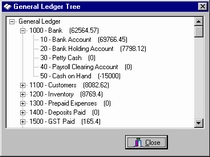 |
| Manual Journal Entries | |
| Journal entries are used to enter records of transactions directly in the General Ledger database (such as a payment on a credit card). Within the General Ledger Journal Entry dialog box, you can set the transaction date, a ledger code, a ledger description, a transaction description, a reference and the applicable Debit or Credit amount. As BusinessSuite takes care of all of the journal postings from the other modules automatically, you only need to use the Journal Entry screen occasionally. Another convenient function of the General Ledger Journal Entry module is the inclusion of templates. The Save Template button in the Journal Entry screen lets you save the details you have entered as a template. The next time you need to make a similar or identical journal entry, you can load the template you have created – saving time on repetitive data entry. |
 |
| Graph | |
| The Graph tab displays both turnover and budget information from the General Ledger module in the form of a bar graph. As the information in the General Ledger module changes, the graph will change. This is an easy way to view your financial situation at a glance and see how your expenses and turnover compare to your budgets. |
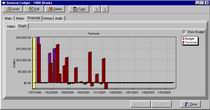 |
| Reports | |
| Of the available reports in the General Ledger module, the Balance Sheet and the Profit and Loss report are arguably the most important. These reports represent the financial information in your General Ledger. The Balance sheet adds the value of your current assets to the value of your noncurrent assets. It then takes from that figure the value of your current liabilities and your noncurrent liabilities. The final result of these calculations gives you your Net Asset value. The second half of the Balance sheet adds the value of your capital and reserves to any retained earnings you may have. To this value is added the total net earnings your company has made this year. The sum of these figures gives you the Net Equity value. This value is always equal to the Net Asset value. The Profit and Loss report takes the cost of the goods (movement of stock) and the value of your purchases away from the value of your revenue to get the Gross profit value. Expenses (such as wages) are then removed from the Gross Profit value to get the Net Profit. Another important financial report is the Trial Balance report. A trial balance provides a list of the totals for the ledgers. |
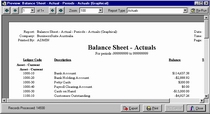 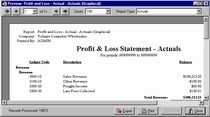 |
| Review | |
| The Journal Review function gives you a list of all the journal entries made by your company. You can review all the journal entries that are posted to the General Ledger or recall a specific journal entry in detail. |
 |
| Consolidation | |
| The General Ledger Consolidation function lets you combine General Ledger data when there is more than one company on your system. For example, if you have created many separate trading companies (and therefore separate company data files) you can consolidate the information into the parent company. The Consolidation ActionButton opens a list of all the companies on your system. From this list, companies to have their ledgers consolidated are selected. The consolidation process will only merge journal entries that have occurred since the last consolidation was performed. |
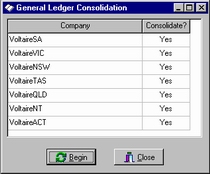 |
| Rollovers | |
| The Rollover function lets you move, or rollover, your database information to the next financial year. Rollovers are performed at the end of the financial year. A rollover will move all Current period information into the Last Year period and add additional trading periods. The flexibility of BusinessSuite lets you to trade well into the next financial year - allowing the time for your accountant to produce your financial figures and end of year adjustments before you are required to rollover. In fact, you can trade for 3 years before a rollover is required. For data integrity, performing rollovers during the current financial year will display a warning and abort the process. |
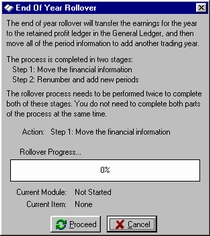 |
Copyright © BusinessSuite Australia. All Rights Reserved.